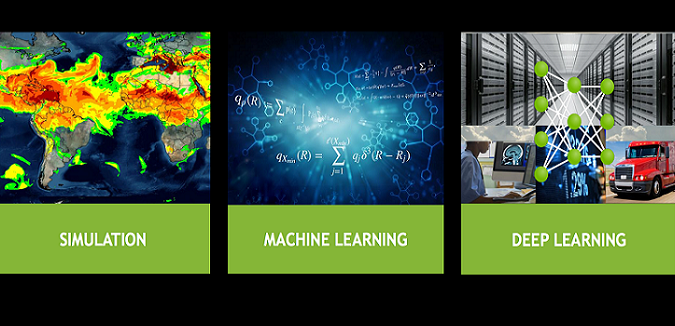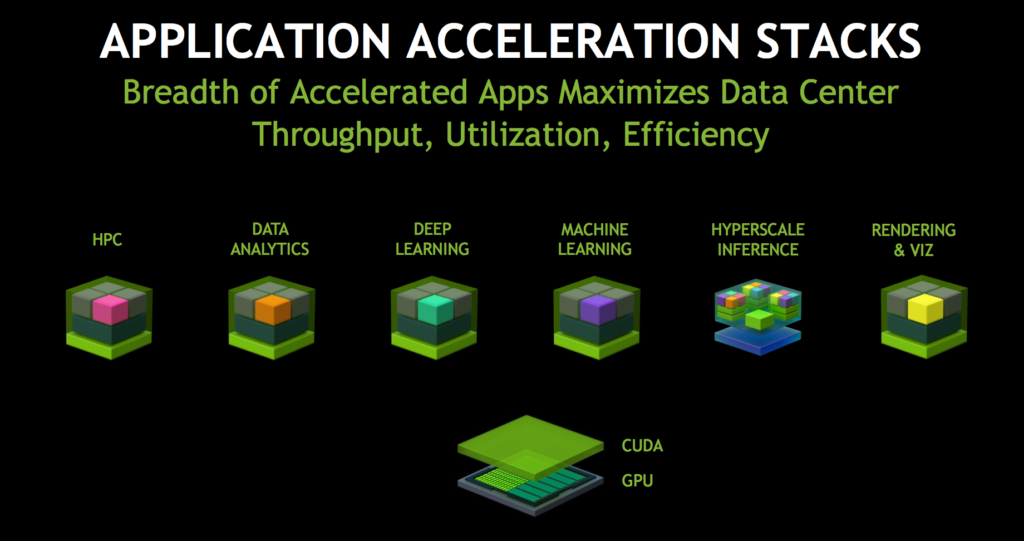For nearly two hours on Monday at SC18, Jensen Huang, CEO of Nvidia, presented his expansive view of the future of HPC (and computing in general) as only he can do. Animated. Backstopped by a stream of data charts, product photos, and even a beautiful image of supernovae, Huang described an accelerator- and AI-driven transformation of computing in which multi-precision processors, emerging software tools, verticalized stacks, containers, and, of course, Nvidia products, would fuel progress forward. Scale-up and scale-out paths would persist for now, he said, but converge over time with DGX-2 and V100 supporting the former and Nvidia’s new T4 GPU driving the latter. This was vintage Jensen.
Strictly speaking, there wasn’t a lot of breaking news – Google’s decision to deploy Nvidia T4 instances along with roll out of expanded container offering were probably the most prominent items.
While most of the challenges and solution approaches Huang cited are familiar, he can perhaps be forgiven his enthusiasm. The GPU, more specifically Nvidia GPUs (and CUDA), have been central to HPC’s effort to cope with Moore’s law’s decline. The rise of accelerator-based heterogeneous architectures is clearly evident in recent Top500 lists. Nvidia GPUs were in 127 systems on the newest list, including Summit and Sierra, now the two fastest supercomputers in the world. Likewise, Nvidia’s embrace of mixed precision capabilities, so essential for machine learning and deep learning performance, is evident in the Tensor Core technology it deployed on the Volta100 and T4 GPUs.
Whether by keen foresight or smart opportunism, Nvidia’s bet on GPUs is paying off handsomely. Traditional modeling & simulation and emerging data-driven AI are both increasingly enabled by GPUs. While much remains to be sorted out regarding how these two worlds will work together, at least near-term, heterogeneous accelerator-based systems are the engines for both. Huang made the case for Nvidia as a first-mover to lead the charge into the new computational order with an eclectic mix of technology discussion and Nvidia announcements spanning HPC performance benchmarks, product market traction, new partner efforts, and praise for open source.
Capturing the full extent of his comments is beyond the scope of this article (link to his recorded video), but here are a few bullets from Huang’s talk plus other key announcements made by Nvidia at SC18:
- Top 500 Penetration. The number of systems using Nvidia GPUs jumped 48 percent jump year over year and is three times greater than five years ago. The two top performers Summit (Oak Ridge National Laboratory) and Sierra (Lawrence Livermore National Lab) combined feature more than 40,000 Nvidia V100 Tensor Core GPUs. For the first time, nearly half of the compute power on the Top500 — 702 of 1,417 petaflops — comes from accelerated systems. Prior to 10 years ago, no accelerated systems appeared on the list.
- DGX-2 Traction. The first Nvidia DGX-2 AI supercomputers in the U.S. have arrived at the nation’s leading research labs – Brookhaven National Laboratory , ORNL, and Sandia National Laboratories reported the DGX-2 systems deliver more than two petaflops from 16 Nvidia Tesla V100 Tensor Core GPUs interconnected with NVSwitch technology. The labs are engaged in work ranging from fusion research and climate simulation to human genomics.
- Google Offers T4. Just two months after its introduction, the new T4 GPU intended for scale out applications is featured in 57 separate server designs, reported Nvidia, and is also now available in the cloud, with the first availability of the T4 for Google Cloud Platform “We have never before seen such rapid adoption of a datacenter processor,” touted Ian Buck, vice president and general manager of Accelerated Computing at Nvidia.
- Container Expansion. Nvidia’s NGC container registry now offers a total of 41 frameworks and applications (up from 18 last year) for deep learning, HPC and HPC visualization. Recent additions include CHROMA, Matlab, MILC, ParaView, RAPIDS and VMD. Nvidia announced new multi-node HPC and visualization containers, which allow supercomputing users to run workloads on large-scale clusters. Also, NGC containers can now be used natively in Singularity, a container technology that is widely adopted at supercomputing sites.
- SC18 Notables. Europe’s and Japan’s fastest supercomputers are also accelerated by Nvidia GPUs. Also released today, the Green500 list, which measures the energy-efficiency of the world’s fastest systems, shows that Nvidia powers 22 of the top 25 “greenest” systems. Five of six finalists for the Gordon Bell Prize, to be awarded during this week’s SC18 conference, were accelerated by Nvidia GPUs.
“This is a breakout year for Nvidia in the world of supercomputing,” said Huang in the release and indeed it has been.
He spent a fair amount of time discussing Nvidia support of its GPU ecosystem noting the backward compatibility of CUDA releases and embrace of a range of open source tools and frameworks were critical to Nvidia efforts to develop standardized vertical stacks. These stacks, he said, will remove much of the drudgery and worry in deploying a wide range of AI functions.
Also notable was the apparent market strength demonstrated by the T4. Among server companies featuring the T4 are Dell EMC, IBM, Lenovo and Supermicro. Roughly the “size of a candy bar”, the low-profile 70-watt T4 GPU has the flexibility to fit into a standard server or any Open Compute Project hyperscale server design. Server designs can range from a single T4 GPU all the way up to 20 GPUs in a single node. T4’s multi-precision capabilities deliver workloads at four different levels of precision, offering 8.1 TFLOPS at FP32, 65 TFLOPS at FP16 as well as 130 TFLOPS of INT8 and 260 TFLOPS of INT4.
All things considered SC18 was a kind of victory lap for Nvidia with Huang confidently proclaiming the best is yet to come. We’ll see.
Link to Jensen Huang’s presentation: https://www.youtube.com/watch?v=c29B-sfzJvY






























































